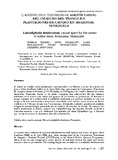Mostrar el registro sencillo del ítem
Lasiodiplodia Theobromae, Agente Causal del Chancro del Tronco en Plantaciones de Caucho en Amazonas, Venezuela
| dc.rights.license | http://creativecommons.org/licenses/by-nc-sa/3.0/ve/ | |
| dc.contributor.author | Rangel, Ronald | |
| dc.contributor.author | Holmquist, Otón | |
| dc.contributor.author | Bracamonte, Lilian | |
| dc.contributor.author | Pietrantonio, Pietro | |
| dc.contributor.author | Cadenas, Aurora | |
| dc.contributor.author | Díaz, Jimmy | |
| dc.date.accessioned | 2017-06-20T16:13:45Z | |
| dc.date.available | 2017-06-20T16:13:45Z | |
| dc.date.issued | 2014-01 | |
| dc.identifier.issn | 0556-6606 | |
| dc.identifier.uri | http://www.saber.ula.ve/handle/123456789/43513 | |
| dc.description.abstract | Se realizó un estudio en las plantaciones experimentales con híbridos y clones de especies del género Hevea brasiliensis (Willd. ex A. Juss.) Müll. Arg., que maneja la Corporación Venezolana de Guayana, División Forestal, (CVG-Forestal), en su Programa de Caucho Natural del estado Amazonas, Venezuela, donde se ha hecho conspicua una enfermedad del tipo chancro indefinido en el tronco y las ramas más gruesas de los árboles en producción. Se describe el hongo causante de la enfermedad (Lasiodiplodia theobromae) y el proceso mediante el cual este hongo es llevado nuevamente a Amazonas e inoculado sobre árboles sanos usando un diseño estadístico de 7 bloques al azar con 7 repeticiones, obteniendo resultados positivos al reaislarlo y lograr la sintomatología presentada por el chancro (Postulados de Koch). Un chancro del tronco relacionado al caucho, causado por Phytophthora spp. fue también descrito en Brasil y Colombia asociado o no a L. theobromae. Los intentos por aislar Phytophthora spp. o Fusarium spp. en nuestros casos de Amazonas, han sido infructuosos. | es_VE |
| dc.language.iso | es | es_VE |
| dc.rights | info:eu-repo/semantics/openAccess | |
| dc.subject | Caucho natural | es_VE |
| dc.subject | Hevea | es_VE |
| dc.subject | Lasiodiplodia theobromae | es_VE |
| dc.subject | Venezuela | es_VE |
| dc.title | Lasiodiplodia Theobromae, Agente Causal del Chancro del Tronco en Plantaciones de Caucho en Amazonas, Venezuela | es_VE |
| dc.type | info:eu-repo/semantics/article | |
| dc.description.abstract1 | A research was conducted in experimental plantations with hybrids and clones of genus Hevea brasiliensis (Willd. ex A. Juss.) Müll. Arg., under management of the Corporación Venezolana de Guayana – División Forestal (CVG-Forest), in the Natural Rubber Amazon Programme, where it has become conspicuous canker disease of indefinite kind in the trunk and thicker branches’ trees in production. The causing fungus was identified as Lasiodiplodia theobromae and the process by which this fungus is brought back to Amazon and inoculated on healthy trees is described; statistical design of seven randomized blocks with 7 replicates result to isolate and achieve description of the symptoms presented by chancre. A trunk canker related to rubber, caused by Phytophthora spp. was also described in Brazil and Colombia with or without Lasiodiplodia theobromae. In our cases attempts to isolate Phytophthora sp. or Fusarium sp. have been unsuccessful. | es_VE |
| dc.description.colacion | 27-40 | es_VE |
| dc.description.email | r.rangel@ula.ve | es_VE |
| dc.description.email | holmquis@ula.ve | es_VE |
| dc.description.email | bracamon@ula.ve | es_VE |
| dc.description.email | pietropm@ula.ve | es_VE |
| dc.description.frecuencia | Semestral | |
| dc.publisher.pais | Venezuela | es_VE |
| dc.subject.facultad | Facultad de Ciencias Forestales y Ambientales | es_VE |
| dc.subject.keywords | Natural rubber | es_VE |
| dc.subject.keywords | Hevea | es_VE |
| dc.subject.keywords | Lasiodiplodia theobromae | es_VE |
| dc.subject.keywords | Venezuela | es_VE |
| dc.subject.publicacionelectronica | Revista Forestal Venezolana | |
| dc.subject.seccion | Revista Forestal Venezolana: Artículos | es_VE |
| dc.subject.thematiccategory | Geografía | es_VE |
| dc.subject.thematiccategory | Medio Ambiente | es_VE |
| dc.subject.tipo | Revistas | es_VE |
| dc.type.media | Texto | es_VE |


